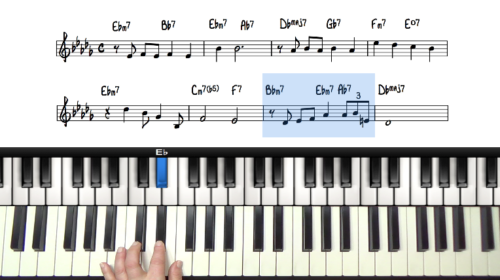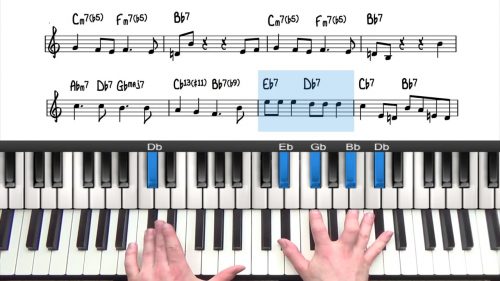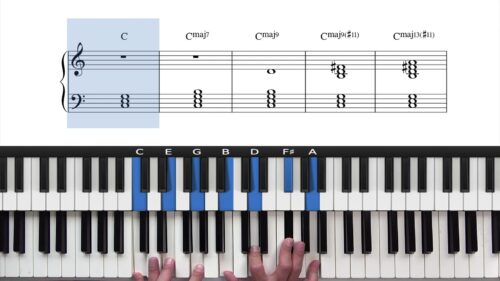"Dream A Little Dream" Simple Arrangement
Welcome to this tutorial on Dream a little Dream. It was first recorded in 1931 by Ozzie Nelson and his Orchestra, it was written by Fabian Andre and Wilbur Schwandt, with lyrics by Gus Kahn.
Most people know and recognise "Dream A Little Dream". It’s so delightful in its melody and lyrics. In this lesson we will jump straight in and get familiar with it’s melody, form and harmony.
Notable Versions Of The Tune
The version by the Mamas and the Papas in 1968 is perhaps the best known version and it has been recorded 60 times. This is one of my favourite versions of the tune because it’s a jazz standard with an equally strong pop tradition.
Then there is also the Ella Fitzgerald and Louis Armstrong jazz version – a must listen-to recording of this great tune.
First We Will Learn The Melody
We’re going to learn this tune in the key of C. This is the key from the Mama’s and the Papas version, and for many of us this is the version we are most familiar with.
This is also a great key for my particular voice. One thing that stands out right away is the extensions that happen in the melody. In measure 4, we have b9 as part of our melody. So this will play later in out our voicings and choice of voicings.
Revisit The Vocal Exercises
We will start by running the melody of the whole tune with our dominant hand, and sing along with "La" or "oo" to see how this key feels for your voice, as well as to speed up the memorisation process through internalisation of the melody.
If you don’t consider yourself a singer, or enjoy singing at all, then you can try the "hummmm" with it.
Understand The Form & The Harmony
So by now you’ve detected the AABA form. Our A Sections are very similar except for the last 2 measure of each 8, changing slightly in timing, but the same chords and notes.
The Key Change In The Bridge
The bridge goes somewhere else and it’s a fascinating key change to Ab, which is the b6 of the key. This is one of the fun surprises that makes this tune so enjoyable to sing and play.
Let’s jump into the harmony now. We’ll use root position triads in the right hand, and then root bass in the left-hand.
Practice Tips
-
Remember that being able to connect to the meaning of the song, and express the love that this particular tune is about, that can make the different from a good performance to a great one.
-
"Dream A Little Dream" is such an efficient and beautiful composition that you really don't need to add much to the harmony.
-
Your singer gets to do such a fun and brilliant melody... so some might feel it's best to keep the harmony simple and clean, as to not interfere.
-
In the next video we'll take it the level of 7th chords and extensions and talk about how to do a jazzer versions.
- Make sure you check out the recommended versions of this tune as highlighted above.







Hello Lyndol,
I have a question regarding the rhythm of the melody in bars 3 and 4. I am able to play the half note, 8th notes and quarter note triplets separately. However, when it comes to playing it altogether in continuation, it seems difficult.
Could you please advise on how to practice this?
Thank you,
Sonal A
Hi Sonal A,
I hear ya! Quarter note triplets in general can be tricky. I have some ideas for how you can integrate that…
#1 – Solfeggi (Solfege) – are you familiar with this method? Isolating the 2 measures (3 &4), you can use the syllables
DA for quarter note
Do Ba for the eight notes
Do Ba La for the triplets
You just work on these 2 measures over and over again slowly at first, then gradually increasing to tempo.
Once it’s integrated in your voice, then you pick only one note on piano – Play and sing this note in the same way.
Then play only with the actual melody notes. Even if it’s out of tempo, you probably will feel and know when a note should land. It’s just a matter of practice at this point.
Solfeggi works because if you can feel and hear the rhythm clearly, then your hands will catch up (with enough time and practice.) The solfeggi helps you to get the proper recording of the rhythm strong in your mind. Then it will come out naturally in your hands.
If you are not familiar with Solfege, feel free to ask more questions about it. It’s especially helpful to you here, if you are not strong in your quarter note triplet timing.
Otherwise, here’s some more options…
#2 – En Boucle – just play that 2 measures over and over again with metronome – slowly at first. Give your self time to think through them and let it be messy. The trick here is repetition. 5 minutes can feel like an eternity, but you’ll find it much easier at the end of that or at least be closer to a fluent expression of that rhythm.
If you need to, play each separate figure for about 1 a minute each, so that it’s loaded into your short term. Then try the combination. Metronomes will be helpful to guide the beats here, but doesn’t need to be fast.
Baby step – play just one note on the piano in the rhythm.
#3 – Inundate your practice with these skills – Any scale you are working on, you can use to integrate these rhythms. ,
You can set to a metronome at a slow pace.
Play first through as a Quarter note
2nd time through as Eight note
Then finally Quarter Note triplet
Then move to the next scale.
By focusing on it this way, the ability to transition from one rhythm figure to a next is being solidified on a universal level, so that when you face it in this melody or another, it will be there for you. You are giving your mind practice Dividing Time.
This is more of a long term solution, but also by combining this method with one or both of the above suggestions, then you will get fluent very quickly.
So much of learning music is just spending enough time with a skill or rhythm so that our bodies can naturally integrate them. If you have a strong sense of rhythm it takes less time, but we all have the ability if we just give our hands and minds enough repetitions. We just can’t give up.
I encourage you to keep going. Try out one of these, or get back in touch with more details such as
– How comfortable you are using your voice to integrate rhythm, and if
– You are familiar with solfeggi.
I’m happy help in a more specific ways if you provide more questions/details of your practice.
All the best!
Lyndol
Thank you so much, Lyndol.
I think I will just work on these steps for now.
Regards,
Sonal A